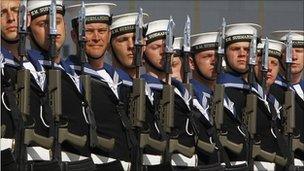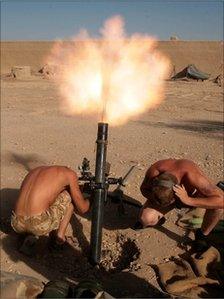Armed forces pension schemes
- Published

The scheme is the fifth largest in the UK's public sector
Which employees does the scheme cover?
All members of the armed forces.
How many sections are there?
There are two main pension schemes for members of the regular armed forces.
The first, known as AFPS 75, started in April 1975 and closed to new joiners on 6 April 2005.
The new one, called Armed Forces Pension Scheme 2005 (or AFPS 05), was brought in for new joiners in April 2005.
How many active deferred and retired members are there?
There are 198,000 active members, 406,000 deferred members, and 399,000 pensioners or their dependents receiving a pension.
What are the principal benefits?
AFPS 75 is non-contributory and the full pension can be taken at age 55.

The fund finances a compensation scheme for death and injury in service as well as a pension
It is a final-salary scheme with the maximum pension, and tax-free lump sum of three times annual pension, available after 34 years as an officer and 37 years (other ranks). This will give a pension worth 48.5% of what is called "representative pay" plus the lump sum.
AFPS 05 is also non-contributory and can be taken at 55. After 35 years of service the pension is worth 50% of final pensionable pay. There is also a tax-free lump sum of three times annual pension. The pension accrues at a rate of 1/70th each year, for up to 40 years.
There is also an early pension scheme, known as the early departure payments (EDP) scheme, which pays a lower level of pension and a lump sum. It applies to those with at least 18 years service who are aged 40 or over.
The pension fund also pays for the Armed Forces Compensation Scheme, which makes lump sum payments or continuing inflation proofed, tax-free, payments for injury, illness or death caused by service.
What percentage of salary do the armed forces pay?
The MoD pays the equivalent of 37% of officers' salaries and 21% of salaries for other ranks.
What are the funding costs of the scheme?
Across all members, the contribution rate was 27.6% of salaries in 2009-10, forecast to rise to 29.5% this year and 34% in the following three years.
Is the scheme funded or unfunded?
Unfunded. It is paid for out of general taxation, not an underlying investment fund.
What is the value of the scheme assets, if any, and its liabilities?

Members of the schemes do not make any contributions from their pay
The liabilities were put at £121bn in the scheme's resource accounts for 2009-10.
What is the average pension in payment?
£8,693 as of 31 March 2010 including lump sum payments.
Have there been any changes or reforms to the scheme in recent years?
The introduction of the new AFPS 05 in 2005.
Are there any further changes in the pipeline?
From April 2011, pensions in payment will increase in line with the consumer prices index (CPI), not the retail prices index (RPI).
Source: MOD